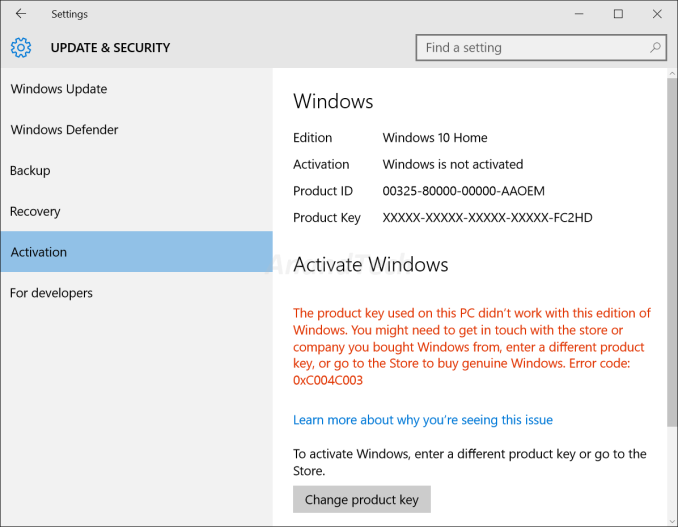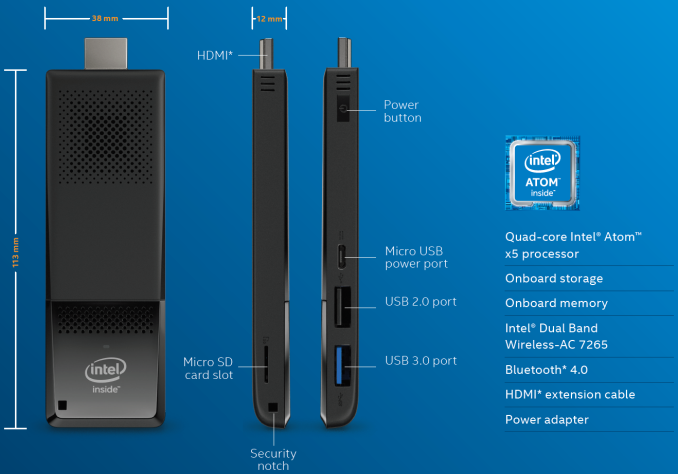The Intel Compute Stick (Cherry Trail) Review
by Ganesh T S on January 14, 2016 8:00 AM EST- Posted in
- Systems
- Intel
- Cherry Trail
- HDMI Stick
- CES 2016
- Compute Stick
Miscellaneous Aspects and Concluding Remarks
Intel has also been putting some effort on the software side for the Compute Stick platform. One of the main problems with the platform is the limited availability of USB ports. In addition, the use-cases often tend to rule out wired I/O peripherals (keyboard and mouse). However, in certain situations (such as the 'entertainment' use-case), the consumer often has a second screen available (either a tablet or a smartphone). Intel has a free Android / iOS app - the Intel Remote Keyboard - to take advantage of the second screen.
The host application comes pre-installed on the Compute Stick and is active at startup as a service. Therefore, one can use it to even enter credentials for system login. It allows the second screen keyboard to act as the primary keyboard for the Compute Stick and the screen itself to act as a trackpad for the mouse pointer on the Compute Stick's display. In our evaluation, the app worked well. Our only wish is for the in-built keyboard in the app to have a 'Tab' key.
Moving on to the business end of the review, we complained in our Bay Trail Compute Stick evaluation that 32GB of primary storage does not cut it on any computing device other than a tablet or smartphone. Unfortunately, the Cherry Trail Compute Stick doesn't solve that problem. Initiating Windows update after boot-up installs the latest build. However, after the whole process is done, Windows basically backs up the previous install in Windows.old. It leaves only 5GB of free space in the eMMC drive (no other programs installed). One needs to manually run Disk Cleanup to remove the previous installation. In the meanwhile, performance suffers. On top of that Windows loses its activation status in the update and refuses to activate.
More importantly, the latest build doesn't have the Wi-Fi drivers for the machine. So, the unit can't communicate with the network at all until the the WLAN drivers are downloaded on another machine, brought in to the Compute Stick via USB and installed manually. It is surprising that the AC7265 drivers are not part of the Win10 update installation.
Coming to the thermal solution, the fan curves are very annoying. In a quiet room, the fan kicks on and off randomly (depending on the CPU temperature and load), and the sudden whine is not pleasing at all. It is very similar to the Bay Trail Compute Stick in this respect. That said, most of the time, the unit is quite silent - almost as if the fan is not running at all.
On the plus side, it is very nice to get a 2x2 AC7265 802.11ac WLAN card in the unit. The improved GPU along with the updated media playback capabilities is also very welcome. CPU performance is not improved much over the Bay Trail version, but the Core M Compute Sticks due later this year should help address that aspect. Intel has been listening to feedback on the Bay Trail Compute Stick and the Cherry Trail iteration has managed to address many of the problems. A few still remain, but there is no reason why these Compute Sticks can't become as popular as the NUC a couple of generations down the line.













80 Comments
View All Comments
ruthan - Thursday, January 14, 2016 - link
Even with Windows 10 license price tag is ridiculous, in comparision with ARM machines, remix mini is afaik fanless and for 40 bucks, yeah bigger form factor but who cares.. If someone needs something so small, bootable boot drive also solution, linux kernel booting almost on everything and almost everywhere is some slow pc "terminal" capable boot from usb.ruthan - Thursday, January 14, 2016 - link
Yeah with present price of memory - is only 2gb and no 64bit 4gb nonsense.DigitalFreak - Thursday, January 14, 2016 - link
"The eMMC capacity is only 32GB and the RAM is only 2GB - two aspects that have an artificial limitation imposed on them by Intel's decision to pre-install Windows 10 Home. Even though the information is not public, it is likely that Microsoft mandates neutering of a PC's hardware specifications in exchange for a lower price for the Windows 10 OEM license."ruthan - Thursday, January 14, 2016 - link
Yeah is probably true both these companies are masters in crippling hw and sw capabilities just for greed.. i think they maked enough.watzupken - Thursday, January 14, 2016 - link
After reading this review, I still don't see any value to the Compute stick. Currently, there are too many shortcomings with it, i.e. Limited storage, memory, very average performance, etc.Hector2 - Thursday, January 14, 2016 - link
I have a fast 3.5GHz 6-core Gulftown Windows PC but use my zippy little Celeron-based $180 Chromebox for almost ALL of my email and internet. The Windows OS needs more memory and compute resources than the Chrome OS. It'd be interesting to see if the Compute stick is as quick as my little Chromebox ... that probably won't happen soon, though.amdwilliam1985 - Thursday, January 14, 2016 - link
It'll be great if the next version comes with USB type c, so it deliveries video, audio, power from 1 connector.darkich - Friday, January 15, 2016 - link
I find these kind of devices to be an incomparably more fascinating pieces of technology than the biggest, baddest, most expensive pc towers out thereMadpacket - Friday, January 15, 2016 - link
Thanks for the review Ganesh. While interesting I'll bite once the Core M versions with more local storage and no whiny fan are available.kelemvor33 - Friday, January 15, 2016 - link
Does it support wiping and reimaging with a Pro/Enterprise version? The original model did not as Intel wouldn't release drivers for it. That made it a pain to use in a business setting since you can't add it to your domain or do much remote management.